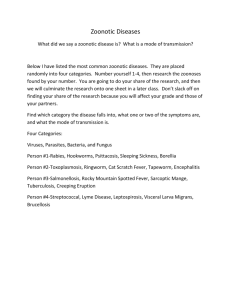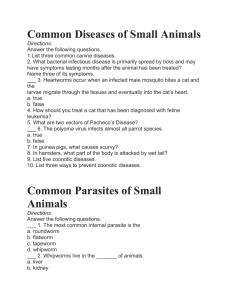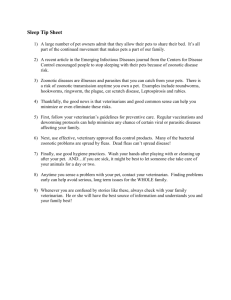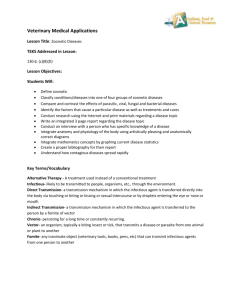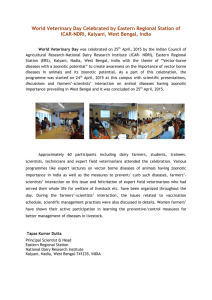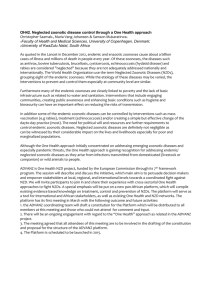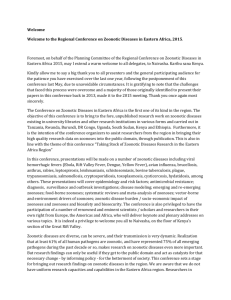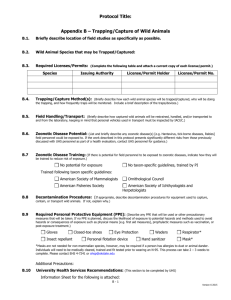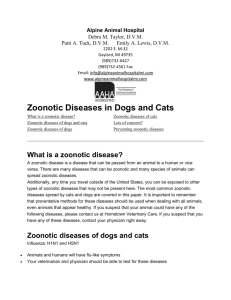View Syllabus
advertisement
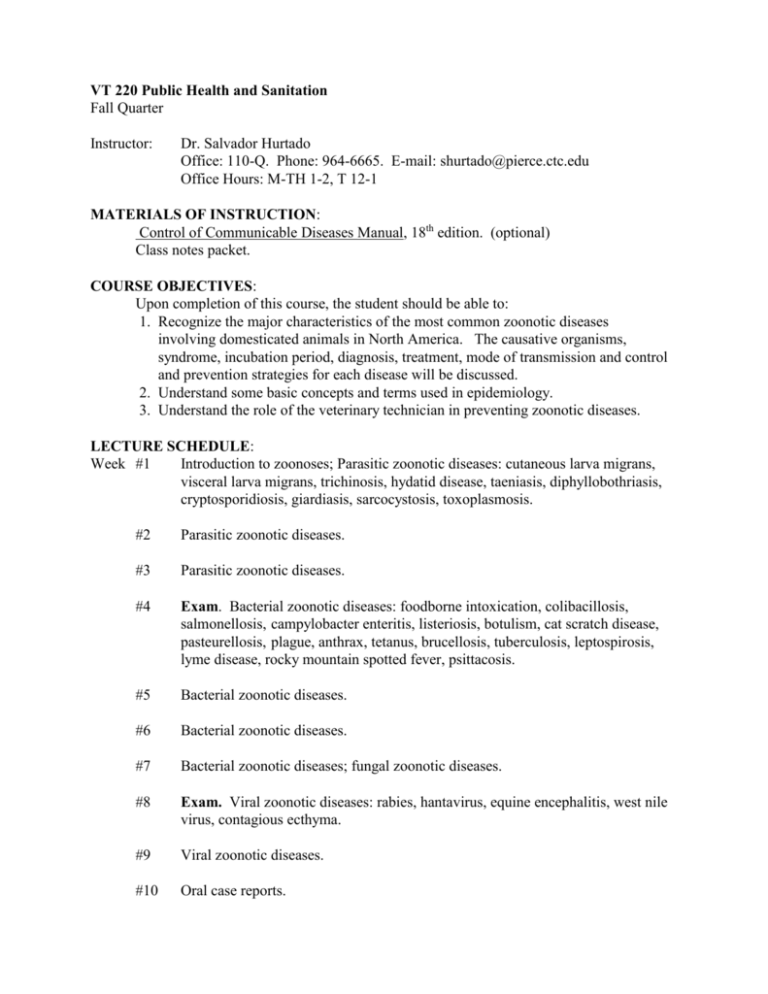
VT 220 Public Health and Sanitation Fall Quarter Instructor: Dr. Salvador Hurtado Office: 110-Q. Phone: 964-6665. E-mail: shurtado@pierce.ctc.edu Office Hours: M-TH 1-2, T 12-1 MATERIALS OF INSTRUCTION: Control of Communicable Diseases Manual, 18th edition. (optional) Class notes packet. COURSE OBJECTIVES: Upon completion of this course, the student should be able to: 1. Recognize the major characteristics of the most common zoonotic diseases involving domesticated animals in North America. The causative organisms, syndrome, incubation period, diagnosis, treatment, mode of transmission and control and prevention strategies for each disease will be discussed. 2. Understand some basic concepts and terms used in epidemiology. 3. Understand the role of the veterinary technician in preventing zoonotic diseases. LECTURE SCHEDULE: Week #1 Introduction to zoonoses; Parasitic zoonotic diseases: cutaneous larva migrans, visceral larva migrans, trichinosis, hydatid disease, taeniasis, diphyllobothriasis, cryptosporidiosis, giardiasis, sarcocystosis, toxoplasmosis. #2 Parasitic zoonotic diseases. #3 Parasitic zoonotic diseases. #4 Exam. Bacterial zoonotic diseases: foodborne intoxication, colibacillosis, salmonellosis, campylobacter enteritis, listeriosis, botulism, cat scratch disease, pasteurellosis, plague, anthrax, tetanus, brucellosis, tuberculosis, leptospirosis, lyme disease, rocky mountain spotted fever, psittacosis. #5 Bacterial zoonotic diseases. #6 Bacterial zoonotic diseases. #7 Bacterial zoonotic diseases; fungal zoonotic diseases. #8 Exam. Viral zoonotic diseases: rabies, hantavirus, equine encephalitis, west nile virus, contagious ecthyma. #9 Viral zoonotic diseases. #10 Oral case reports. VT 220 Public Health and Sanitation page 2 GRADING PROCEDURE: 2 Midterm exams (100 pts. each) 1 Final exam * Client information sheet *Oral case report presentation = = = = 200 pts. 100 pts. 50 pts. 25 pts. 375 Total Points Grades will be assigned based on the percentage of total points attained in accordance with the departmental grading system. Wearing an approved uniform is required in all lectures. *Each student will be required to prepare a client information sheet on a zoonotic disease. The student is free to choose their zoonotic disease topic from the approved list provided by the instructor. The document must be written in such a way that a lay person might be able to understand the etiology, syndrome, diagnostic tests, and the treatment and prevention strategies associated with the disease. *Each student will also be asked to present a 3-5 minute oral report regarding an actual case involving the zoonotic disease chosen for the client information sheet. The zoonotic disease case could be one that the student was involved with, has personal knowledge of, or has researched in the literature. The oral case report should include the history, clinical signs that the animal presented, the symptoms exhibited by the affected human, how the diagnosis was made, and what therapy and control measures were implemented. Any relevant information of the zoonotic disease involved should accompany the case report. The presentations will be judged on their organization and their effectiveness to convey the necessary information. Eye contact with the audience during the presentation is required. Merely reading from a prepared written report or note cards is unacceptable. Students with disabilities who believe they may need academic adjustments, auxiliary aids or services to fully participate in course activities or meet course requirements are encouraged to register with the Access & Disability Services (ADS) Office, Room 300K in the cascade Building. You may also call the ADS Office to make an appointment to meet with the ADS Coordinator at (253) 964-6526 or 964-6527. Students requesting academic adjustments must obtain the approved Quarterly Academic Adjustments, Auxiliary Aids or Services (green) form provided by ADS before any adjustments are made. For life-threatening emergencies call 911 and then Campus Safety. In the event of an emergency evacuation, gather all personal belongings and leave the building using the nearest safe exit. Be prepared to be outside for a minimum of an hour and stand a minimum of 200 feet from any building or structure. Do not attempt to re-enter the building until instructed. Should a class be cancelled, it is your responsibility to keep up on reading, homework, and deliverable assignments.
